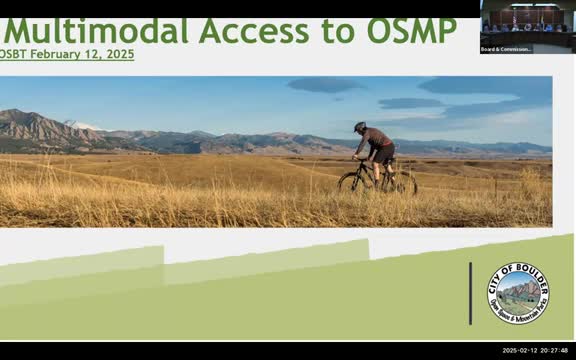OSMP starts planning a toolkit to increase multimodal access to open space; staff flag communications as low‑cost early action
February 15, 2025 | Boulder, Boulder County, Colorado
This article was created by AI summarizing key points discussed. AI makes mistakes, so for full details and context, please refer to the video of the full meeting. Please report any errors so we can fix them. Report an error »

Open Space and Mountain Parks staff on Feb. 12 presented a planning approach for improving multimodal access to OSMP trailheads and key access points, aligning the work with the City of Boulder's citywide strategic plan goal (7C) and related land‑use and transportation guidance.
Lede: OSMP intends to develop a prioritized toolkit of interventions — communications, modest infrastructure, and connectivity projects — to increase walking, biking and transit access to open space and reduce single‑occupant vehicle trips.
Nut graf: Staff proposed a three‑phase process (data review; development of a prioritized toolkit and feasibility analysis; a draft implementation plan with cost estimates and partners) and said a near‑term, low‑cost emphasis should be communications and behavior‑change work while larger infrastructure needs may require multiagency capital funding and longer lead times.
What staff described: Deputy director Jeff Haley summarized data from the OSMP visitor origin and survey work showing about half of visitors arrive by vehicle and that other modes (walking, biking, running) make up a substantial share. Staff said the project will mine existing POVs, counter and facility data to identify access points where a "needle can be moved" and then develop a menu of interventions — bicycle parking, low‑stress bike connections, shuttles, signage, micro‑mobility and communications and outreach campaigns.
Communications and behavior change: Several trustees emphasized communications and outreach as early, low‑cost actions. Trustee Sarah said the project must include a behavior‑change element, noting that partnerships and targeted campaigns can create demand for alternative transportation. Staff agreed and listed communications and outreach as near‑term items that could be implemented without multiagency dependencies.
Coordination and timing: Staff said some actions will require external partnerships (City Transportation, CDOT, RTD) and longer timelines; others are in OSMP's control. The project charter and scope will be refined in coming months, with a Q3–Q4 phase to develop feasibility and a July update to the board; staff expect a prioritized plan within roughly a year to guide implementation and budget requests.
Next steps: Staff will refine the project scope, begin data mining with the human dimensions team and convene a project team to draft the toolkit and prioritized interventions. They will continue outreach with transportation staff and other partners and return with progress updates and draft priorities.
Lede: OSMP intends to develop a prioritized toolkit of interventions — communications, modest infrastructure, and connectivity projects — to increase walking, biking and transit access to open space and reduce single‑occupant vehicle trips.
Nut graf: Staff proposed a three‑phase process (data review; development of a prioritized toolkit and feasibility analysis; a draft implementation plan with cost estimates and partners) and said a near‑term, low‑cost emphasis should be communications and behavior‑change work while larger infrastructure needs may require multiagency capital funding and longer lead times.
What staff described: Deputy director Jeff Haley summarized data from the OSMP visitor origin and survey work showing about half of visitors arrive by vehicle and that other modes (walking, biking, running) make up a substantial share. Staff said the project will mine existing POVs, counter and facility data to identify access points where a "needle can be moved" and then develop a menu of interventions — bicycle parking, low‑stress bike connections, shuttles, signage, micro‑mobility and communications and outreach campaigns.
Communications and behavior change: Several trustees emphasized communications and outreach as early, low‑cost actions. Trustee Sarah said the project must include a behavior‑change element, noting that partnerships and targeted campaigns can create demand for alternative transportation. Staff agreed and listed communications and outreach as near‑term items that could be implemented without multiagency dependencies.
Coordination and timing: Staff said some actions will require external partnerships (City Transportation, CDOT, RTD) and longer timelines; others are in OSMP's control. The project charter and scope will be refined in coming months, with a Q3–Q4 phase to develop feasibility and a July update to the board; staff expect a prioritized plan within roughly a year to guide implementation and budget requests.
Next steps: Staff will refine the project scope, begin data mining with the human dimensions team and convene a project team to draft the toolkit and prioritized interventions. They will continue outreach with transportation staff and other partners and return with progress updates and draft priorities.
View full meeting
This article is based on a recent meeting—watch the full video and explore the complete transcript for deeper insights into the discussion.
View full meeting
